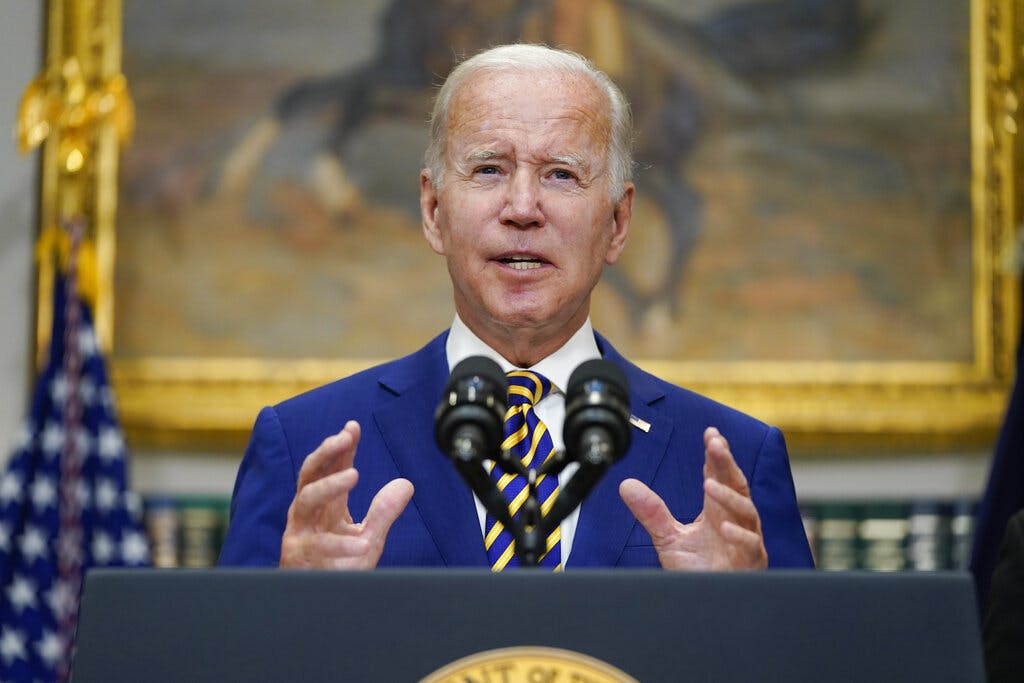Biden Administration Is Expanding Taxing and Spending at a Rate That Is Staggering
Does America really want a federal government two or three times more expensive than the one at the end of the Clinton administration?

In the rows of black and white numbers released by the White House budget office is evidence of something that you may have suspected — the federal government is expanding at a staggering pace.
Compare the 2023 midsession review President Biden put out this month to the 2020 midsession review — the last pre-pandemic one from the Trump administration, released July 19, 2019. The government is collecting more in taxes.
In 2022, receipts were $4,941,000,000,000 in 2022, which is $4.9 trillion. In 2018, tax receipts were a mere $3,330,000,000,000, or $3.3 trillion.
If you think Congress has prevented the worst of Mr. Biden’s tax increases from passing, you may be right, but the Biden administration has still meant a roughly $1.6 trillion annual tax increase on Americans.
Plus, that $1.6 trillion tax increase is before the 87,000 new IRS agents funded by the latest law to increase prices, the Inflation Reduction Act. Mr. Biden, signing the legislation into law on August 16, 2022, praised it as “a godsend” that creates “a fairer tax system.”
Rising tax receipts in an environment of economic growth and lowered tax rates are one thing. Under Mr. Biden, though, the increased tax collections are a sign that the government is taking a larger bite out of the overall economy.
The $3.3 trillion the government took in 2018 was a 16.5 percent share of the gross domestic product. The share of the economy represented by the $4.9 trillion collected in 2022 was, at 20 percent, or one of every five dollars, a staggering 20.1 percent higher than in 2018.
Government spending has soared alongside the taxing. Federal outlays in 2022 are an estimated $5,972,000,000,000, or nearly $6 trillion. In 2018, federal outlays were $4,109,000,000,000, or about $4.1 trillion.
Measured as a percentage of the U.S. economy, spending is also soaring. Outlays were 24.2 percent of GDP in 2022, compared to 20.3 percent of GDP in 2018. That increase of 3.9 percentage points may not seem that large, but in an economy the size of America’s, it is huge.
These numbers are way out of line with long-term practices. The Office of Management and Budget has historical tables going back to 1930 showing that the only other times receipts as a percent of GDP hit 20 percent were during World War II and in 2000, a year that George W. Bush was elected with a promise of a tax cut. As for spending, outlays as a percent of GDP hit 24 percent only during World War II and in 2009 in response to the financial crisis.
Each piece of the spending has its justifications. More than $13.5 billion in U.S. security assistance to Ukraine has helped that country fight back against Russian aggression. Pandemic response and relief spending, begun during the Trump administration, helped develop and rapidly deploy vaccines against Covid-19. Some say the government’s pandemic response helped to prevent worse economic damage than would have occurred in its absence.
Even so, the temptation in Washington is for new spending, initially justified by emergency circumstances — a war in Ukraine, a Covid-19 pandemic — never really to go away. Instead, it winds up becoming part of the baseline used for future taxing and spending.
The increased spending is easier to sustain so long as the federal government can borrow at near-zero interest rates or, relatedly, have its bonds purchased by a Federal Reserve that can electronically create money.
That approach, however, is colliding with higher interest rates and the reality of 9 percent inflation. The federal government is taxing away one out of five of your dollars outright. Now, with the four dollars out of five you have remaining, you have to try to buy clothing and gasoline and food and housing that is more expensive than it used to be.
Roughly 20 years ago, at the beginning of the George W. Bush administration, the federal government was about a $2 trillion a year operation. Nowadays, it’s a $5 trillion or $6 trillion a year operation.
Are the services you get from the federal government three times as good as they were 20 years ago? Is the Post Office, or the National Park Service, or the Navy, or NASA, or the interstate highways, three times as good?
You could say that is a story about inflation, but even in the government’s “constant dollars,” which account for inflation, the size of the federal government has roughly doubled.
Reasonable people may differ over the size of government’s temporary response to a crisis. But the taxers and spenders always have a crisis at the ready: the climate crisis, the student debt crisis, the opioid crisis.
Does America really want or need a federal government two or three times more expensive than it was at the end of eight years of the Clinton-Gore administration? A federal government that is taxing and spending at near record levels?
At a certain point it becomes less a technical economic question than a philosophical question about the balance between the private sector and the insatiable state.

